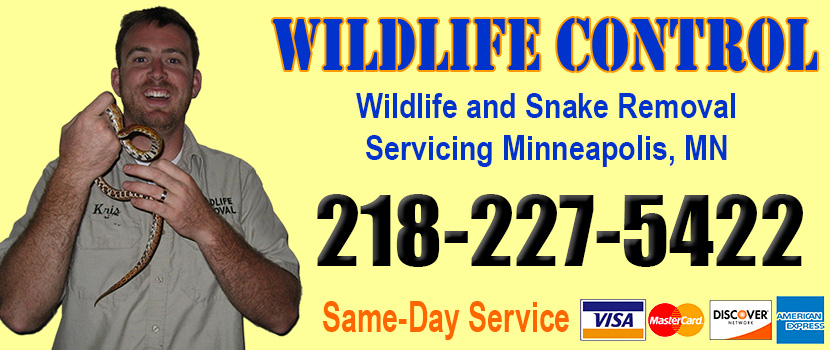
Welcome to minneapolissnakes.com! I am David, a snake enthusiast living in Minneapolis, MN. Many people don't know that Minneapolis is in fact full of snakes! You just need to know where to find them - they can often be shy and elusive. Some Minnesota snake species are more common outside of the city limits, in different parts of Hennepin County MN, but many types of snakes are indeed common in the more urban parts of Minneapolis. This guide is meant to help educate you about the beautiful snakes of Minneapolis, and to help you identify the most common snakes of Minneapolis, as well as the venomous snakes of Minneapolis that you should learn to recognize and avoid. If you want more detail, click here for my complete list of ALL snake species in Minneapolis. Remember the following:
- Most snakes of Minneapolis are harmless and don't want to encounter you
- Venomous snakes exist but are uncommon in Minneapolis, Minnesota
- Snakes eat rats and mice and are a valuable part of the Minnesota ecosystem
- Never kill a snake - if you leave a snake alone, it will leave you alone.
Common Snake Species in Minneapolis
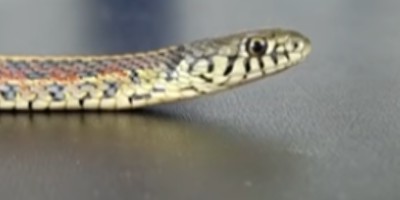 Common garter snake:
These snakes are usually black or brown, with a yellow stripe running down the center of their back and one down each side on the second row of scales and the third row. The stripes on the side of the garter snake blend in with the color of the snake's belly. The area between the stripes is usually checkered with yellow or red patches or black. However, the garter snakes of eastern Minnesota are known to have more yellow coloration than red. For some garter snakes, there might be red coloration on the bottom of their tails. They are 22-32 inches long. They are found throughout Minnesota. During the winter, they hibernate in burrows, rock crevices, or ant mounds to keep from freezing. They feed on frogs, small mammals, earthworms, and insects.
Common garter snake:
These snakes are usually black or brown, with a yellow stripe running down the center of their back and one down each side on the second row of scales and the third row. The stripes on the side of the garter snake blend in with the color of the snake's belly. The area between the stripes is usually checkered with yellow or red patches or black. However, the garter snakes of eastern Minnesota are known to have more yellow coloration than red. For some garter snakes, there might be red coloration on the bottom of their tails. They are 22-32 inches long. They are found throughout Minnesota. During the winter, they hibernate in burrows, rock crevices, or ant mounds to keep from freezing. They feed on frogs, small mammals, earthworms, and insects.
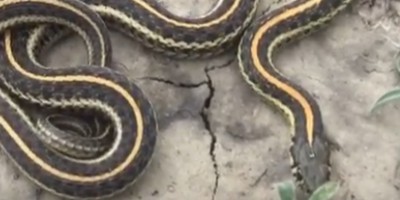 Plain garter snake:
Plain garter snakes are brown or black, with an orange or yellow colored stripe running down the center of their backs, and one down their side, on the third and fourth scale rows. The scales do not blend in with the color of the belly. The area between the stripes is usually black or checkered with a green, yellow, brown, or red coloration. They have a cream or grey colored belly, with rows of dark spots down their sides. Black vertical bars run along their lips. They are 15-28 inches long. They occur in the prairie grassland biome and deciduous forest biome in Minneapolis. During the winter, they hibernate in burrows or ground holes. They also like open spaces. Plain garter snakes feed on earthworms, snails, slugs, fishes, frogs, birds, and small mammals.
Plain garter snake:
Plain garter snakes are brown or black, with an orange or yellow colored stripe running down the center of their backs, and one down their side, on the third and fourth scale rows. The scales do not blend in with the color of the belly. The area between the stripes is usually black or checkered with a green, yellow, brown, or red coloration. They have a cream or grey colored belly, with rows of dark spots down their sides. Black vertical bars run along their lips. They are 15-28 inches long. They occur in the prairie grassland biome and deciduous forest biome in Minneapolis. During the winter, they hibernate in burrows or ground holes. They also like open spaces. Plain garter snakes feed on earthworms, snails, slugs, fishes, frogs, birds, and small mammals.
Venomous Snake Species in Minneapolis
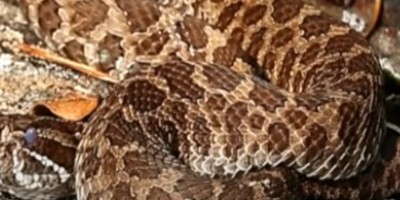 Massasauga snake:
This endangered species can be tricky to identify because they are similar to many other harmless snake species (fox snakes, hognose snakes, bullsnakes, and water snakes). Massasauga snakes are black or grey, with dark brown blotches on their back and smaller blotches on their sides. They have a dark colored rattle at the end of their tails. These medium-sized snakes have a length of 18.5-30 inches. It has a gray-brown background, with a pattern of dark brown patches, with a row of similar patches at the sides. The tail of the massasauga is ringed, with bands having the same color as the dorsal spots. The rattle of the tail is segmented. One of three subspecies of massasauga is found in the upper Midwest and southern Ontario. They also occur on the Wisconsin side of the Mississippi River. They prefer wet habitats like marshes, swamps, and bogs. They also live in open fields, pastures, and woods during the summer. They essentially need areas with sun and shade to regulate their temperature. During winter, they live in burrows, rock cracks, and wood stumps. The massasauga feeds on small rodents like voles and mice. They also eat frogs and snakes.
Massasauga snake:
This endangered species can be tricky to identify because they are similar to many other harmless snake species (fox snakes, hognose snakes, bullsnakes, and water snakes). Massasauga snakes are black or grey, with dark brown blotches on their back and smaller blotches on their sides. They have a dark colored rattle at the end of their tails. These medium-sized snakes have a length of 18.5-30 inches. It has a gray-brown background, with a pattern of dark brown patches, with a row of similar patches at the sides. The tail of the massasauga is ringed, with bands having the same color as the dorsal spots. The rattle of the tail is segmented. One of three subspecies of massasauga is found in the upper Midwest and southern Ontario. They also occur on the Wisconsin side of the Mississippi River. They prefer wet habitats like marshes, swamps, and bogs. They also live in open fields, pastures, and woods during the summer. They essentially need areas with sun and shade to regulate their temperature. During winter, they live in burrows, rock cracks, and wood stumps. The massasauga feeds on small rodents like voles and mice. They also eat frogs and snakes.
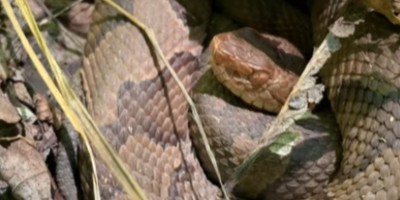 Timber rattlesnake:
This threatened snake species may be yellow, brown, or gray with v-shaped markings, with unevenly cut edges across its body. In some species, these v-shaped markings are spotted in the snake's neck region. They have a fine all-black tail, with a tan rattle at the end. The head of the snake is unmarked and triangular, while their necks are narrow. They have elliptical pupils and a heat-sensitive pit between their eyes and nostrils. It is a large snake, with a length of 31.5-48 inches. It occurs in the bluff lands of southeastern Minnesota, forest bluffs, south-facing rock outcrops, and bluff prairies. It can be found in the Mississippi River valley in particular. Their wintering dens are often located in bluff prairies found on steep, south or west-facing hillsides, with rock outcroppings and ledges. In May, these snakes emerge from their dens and sunbathe on ledges and outcroppings. Non-pregnant females and males leave the den around the end of May to the middle of June. The pregnant females remain around their dens until September when they give birth to their young ones live. They feed on rodents like mice and small birds.
Timber rattlesnake:
This threatened snake species may be yellow, brown, or gray with v-shaped markings, with unevenly cut edges across its body. In some species, these v-shaped markings are spotted in the snake's neck region. They have a fine all-black tail, with a tan rattle at the end. The head of the snake is unmarked and triangular, while their necks are narrow. They have elliptical pupils and a heat-sensitive pit between their eyes and nostrils. It is a large snake, with a length of 31.5-48 inches. It occurs in the bluff lands of southeastern Minnesota, forest bluffs, south-facing rock outcrops, and bluff prairies. It can be found in the Mississippi River valley in particular. Their wintering dens are often located in bluff prairies found on steep, south or west-facing hillsides, with rock outcroppings and ledges. In May, these snakes emerge from their dens and sunbathe on ledges and outcroppings. Non-pregnant females and males leave the den around the end of May to the middle of June. The pregnant females remain around their dens until September when they give birth to their young ones live. They feed on rodents like mice and small birds.
If you're unsure, you can email me a photo of the snake at info@minneapolissnakes.com and I will email you back with the snake's species. If you found a snake skin, read my Found a Skin? page, and you can email me a photo of the skin, and I'll identify the snake for you. If you need professional Minneapolis snake removal help, click my Get Help page, or see the below website sponsor I found, who provides that service.
Remember, the term is not poisonous snakes of Minneapolis, it's venomous snakes of Minneapolis. Poison is generally something you eat, and venom is injected into you. That said, dangerous snakes are very rare in Minneapolis. The few venomous snakes of Hennepin County are rarely seen. But they are commonly misidentified, so learn about all the snake species of Minneapolis in order to correctly identify them. These snakes are usually also found in the surrounding towns of Maple Grove, Brooklyn Park, Bloomington, Eden Prairie, Plymouth, Minnetonka, Edina, Brooklyn Center, Richfield, Hopkins, Wayzata, Champlin, Golden Valley, Crystal, Osseo, Rogers, Excelsior, Mound, St. Louis Park, Robbinsdale, New Hope, Orono, Long Lake, Maple Plain, Minnetrista, Shorewood, Deephaven, Medina, Loretto, Spring Park, Dayton, Medicine Lake, Saint Bonifacius, Tonka Bay, Corcoran, and the surrounding areas.
Read our article about:
Snake Hibernation Facts
minneapolissnakes.com domain and hosting costs made possible by the generous support of this sponsor:
